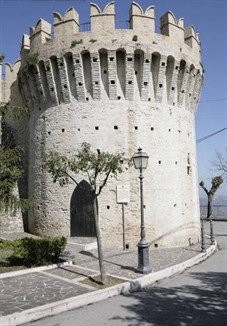Other possessions in Abruzzo
The Cathedral of Atri testifies to the artistic interests of the Acquaviva: Andrea Matteo III commissioned the paintings of the Nativity and of the Flagellation to an Iberian painter of high quality, perhaps Pietro da Aponte, sending them to the Cathedral of Atri, where they are today. A portrait of the duke is likely, moreover, to be the one which is visible in the choir of the cathedral.
 A visit can also be made to Cellino Attanasio, about 20 kilometres away, which was once the heart of the duchy, where Andrea Matteo III restored the fortress (photo) and the church of Santa Maria la Nova (Saint Mary the New), enriching it with paraments and furniture, with paintings by Niccolò di Bonaccorso, Jacobello da Fiore, Andrea Delitio; and in which, in the choir behind the altar, is the tomb of Giovanni Battista Acquaviva (died at age 14), depicted lying on the tomb, with two angels holding the coat of arms.
A visit can also be made to Cellino Attanasio, about 20 kilometres away, which was once the heart of the duchy, where Andrea Matteo III restored the fortress (photo) and the church of Santa Maria la Nova (Saint Mary the New), enriching it with paraments and furniture, with paintings by Niccolò di Bonaccorso, Jacobello da Fiore, Andrea Delitio; and in which, in the choir behind the altar, is the tomb of Giovanni Battista Acquaviva (died at age 14), depicted lying on the tomb, with two angels holding the coat of arms.
Even in Giulianova there are interesting traces of the Acquaviva family. The old town (Giulianova Alta) is an interesting example of newly founded cities. Giulio Antonio Acquaviva founded it, in fact, in 1470, on the foundation of a fortified village on the northern borders of the kingdom, where the inhabitants of nearby Castel San Flaviano had gathered, plagued by malari. It was called Giulia Nova and was built for defensive purposes, at a time in which there was an escalation of attacks by the Turks along the Adriatic coast. But there were also economic reasons related to the concrete possibilities of agricultural development in the area including substantial migration flows of Slaves and Albanians, fleeing the Turks which constituted a significant channel for labour in logging operations and the cultivation of the land. The new foundation was conceived simultaneously as a fortress and agricultural village. Humanistic cultural influences were not absent from its creation which also led other Italian nobles, in various territories of the peninsula, to build ideal cities. Giulianova still retains a unique and interesting urban structure and an imposing cathedral, dedicated to Saint Flavian, the construction of which began in 1470 at the behest of the duke, and that houses works of art of a certain value.
